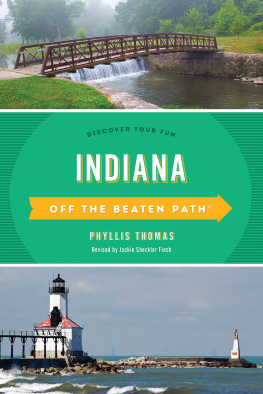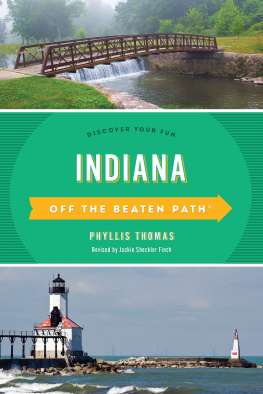Jackie Sheckler Finch has written about a wide array of topicsfrom birth to death, with all the joy and sorrow in between. An award-winning journalist and photographer, Jackie has done more than a dozen travel guidebooks for Globe Pequot and is a member of the Society of American Travel Writers and the Midwest Travel Journalists Association. She has been named the Mark Twain Travel Writer of the Year a record five times, in 1998, 2001, 2003, 2007, and 2012. One of her greatest joys is taking to the road to find the fascinating people and places that wait over the hill and around the next bend.
Southeast Michigan, a region of seven counties, revolves around metropolitan Detroit, which sprawls into three of them. And Detroit revolves around automobiles. Its as simple as that.
Known best throughout the country as Motor City, Detroit carries several other titles, including Motown, after the recording company that produced such famous singers as Diana Ross and Stevie Wonder before it fled to Los Angeles from its studio on Woodward Avenue. The city was also home to the nations oldest state fair (the Michigan State Fair dated to 1849) until it was closed after funding cuts in 2009. On May 30, 2012, it was announced that the Michigan State Fair would be replaced by the Great Lakes Agricultural State Fair, which was held August 31 through September 3, 2012, at the Suburban Collection Showplace in the Detroit suburb of Novi. In 2013, Fifth Third Bank became the sponsor so the name became the Fifth Third Bank Michigan State Fair with a private entity, Michigan State Fair LLC, organizing the annual event. The fair is still held in Novi at the Suburban Collection Showplace. Detroit and its neighboring suburbs wear many faces: some are good, some others are unjustly earned, but the least recognized one is that of a destination for travelers. Detroit is the twenty-fourth
SOUTHEAST MICHIGAN

largest city in the country, yet despite its size many tourists consider it very much off the beaten path. Depart from the city and the rest of Southeast Michigan changes quickly, from the urban sprawl to the rolling hills and lakes of northern Oakland County, the blue water of St. Clair and Port Huron, and the culture and carefree college ways of Ann Arbor, the home of the University of Michigan.
Until the 1870s, Detroitwas a commercial center for farmers, but at the end of that century the first automobiles appeared, as Ransom E. Olds and Henry Ford began tinkering with horseless carriages. By 1903, Ford had organized the Ford Motor Company, and when he pioneered the assembly-line method of building cars and introduced the Model T, the vehicle for the common man, Detroits place as the automobile capital of the world was established.
Cars are a way of life in Detroit. Michigan boasts of having the first mile of concrete rural highway (1909), the first traffic light (1915), and the first urban freeway free of those annoying stoplights (1942). The best-known place to view this history of cars and their immense effect on the American way of life is The Henry Ford, home of Greenfield Village and Henry Ford Museum(3139826001 or 8008355237; thehenryford.org ), a 260-acre complex with 100 historic buildings in Dearbornthat has become the nations largest indoor and outdoor museum.
A $200 million upgrade of Greenfield Village in 2004 resulted in Americas Greatest Historical Attraction being extensively redesigned and for the first time open from mid-April through New Years Eve. Now the streets of the turn-of-the-20th-century village are lined with 331 lampposts, while such famous buildings as Thomas Edisons laboratory from Menlo Park, New Jersey; the Wright Brothers Ohio cycle workshop; and the Logan County Courthouse where Abraham Lincoln first practiced law are heated for visitors who arrive outside the summer months. The adjacent Henry Ford Museum also features new exhibits, including the bus where in 1955 Rosa Parks refused to give up her seat, thus igniting Americas civil rights movement.
So much history, so little time to absorb it all. Keep in mind that the village and the museum are each a separate attraction with a separate admission price, and each requires a good part of a day to view. Car buffs are fascinated by the Henry Ford Museum, especially its main attraction, the Automobile in American Life, an ode to the motorcar culture that is the social history of 20th-century America. Families and children love Greenfield Village.
Henry Ford Museum Home of Priceless American Memorabilia
A glass vial with the dying breath of famed inventor Thomas Edison.
The maroon chair, still bloodstained, where President Abraham Lincoln was assassinated at Fords Theatre.
A folding camp bed that General George Washington actually slept in during the Revolutionary War.
Henry Ford was a collector. As one of the worlds first billionaires, Ford had the money to collect whatever struck his fancy. Instead of expensive works of art or precious gems, however, Ford liked to save pieces of everyday life from the past.
A quote from Ford explains why he was so interested in his unusual collection:
When I went to our American history books to learn how our forefathers harrowed the land, I discovered that the historians knew nothing about harrows, Ford says.





